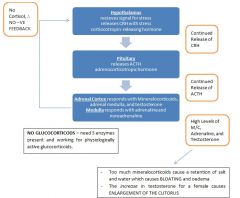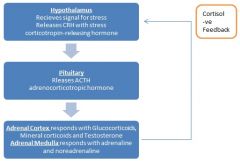![]()
![]()
![]()
Use LEFT and RIGHT arrow keys to navigate between flashcards;
Use UP and DOWN arrow keys to flip the card;
H to show hint;
A reads text to speech;
19 Cards in this Set
- Front
- Back
|
What is regarded as the controlling centre of the endocrine system?
|
The hypothalamus-pituitary axis
|
|
|
Why is the hypothalamus-pituitary axis considered the controlling centre of the endocrine system?
|
It receives a variety of hormonal, neural, and other stimuli and responds by sending out hormones to the pituitary system
|
|
|
What hormones does the anterior pituitary gland release?
|
ADCH, TSH, growth hormone, follicle stimulating hormone
|
|
|
What uses the portal venous system to send hormones to the anterior pituitary?
|
The hypothalamus
|
|
|
What produces and stores oxytocin and ADH in the posterior pituitary?
|
The hypothalamus
|
|
|
By what does the hypothalamus send hormones to stimulate the posterior pituitary?
|
A neural connection
|
|
|
What are the main physiological effects of growth hormone on growth?
|
- increases protein synthesis
- increases the amount of cartilage - activating osteoblasts |
|
|
What are the main physiological effects of growth hormone on metabolism?
|
- increases circulating blood glucose
- induces an insensitivity to insulin |
|
|
What are the clinical manifestations of hyper-secretion of growth hormone?
|
- enlarged organs
- enlarged facial features - excess growth in length of bones at the epiphyseal plates (children) - excess glucose in the blood and insulin resistance (hyperglycemia) (diabetes mellitus) - glucose in the urine (kidneys cannot reabsorb all the glucose - |
|
|
What are the clinical manifestations of hypo-secretion of growth hormone?
|
- decrease in protein synthesis
- decrease in activation of osteoblasts (short stature in children) - decrease in formation of cartilage (under-developed organs) - decrease insensitivity to insulin - decrease in blood glucose levels - increased susceptibility to hypoglycemia in times of stress |
|
|
What is "insulin resistance"?
|
The body's cells, which need glucose, are not responsive to the insulin produced by the pancreas.
|
|
|
How can someone become resistant to endogenous insulin?
|
- insulin doesn't bind to receptors properly due to a change in structure
- the second messenger in decreasing blood glucose does not work properly: does not send a message to the nucleus to upregulate glucose transport carriers to bring glucose into the cell and out of the bloodstream |
|
|
What physiological actions do the mineralocorticoids have?
|
- save salt (Aldosterone) and in the process waste potassium and sodium and potassium are proportional to one another in the body
- ADH also saves water |
|
|
What physiological actions do the glucocorticoids have?
|
- main action is to increase blood glucose levels
|
|
|
How do the glucocorticoids increase blood glucose levels?
|
- breaking down proteins and using them as energy supply
- examples of proteins that are broken down include blood vessels and skin |
|
|
What physiological actions do the androgens have?
|
- androgens are anabolic steroids that mainly act to build muscles
- excess in females causes masculinisation: chin hair, excess hair in unwanted places, and enlargement of the clitorus |
|
|
What physiological actions does adrenaline have?
|
- increases heart rate
- dilates pupils - creates coldness in the extremities |
|
|
Using a flow chart including negative feedback mechanisms, explain why a female with congenital adrenal hyperplasia demonstrates virilisation of the genitals.
|

|
|
|
Draw a flow chart depicting the adrenal cortex and the stress response.
|

|

